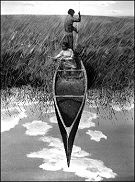| U.S. public policy toward the American Indian at the end of the nineteenth century had as its central purpose the acquisition of Indian lands and resources. They also attempted to reflect a familiar charitable response to the realities of the poverty and dependency that were caused by that policy. Options for independence and self-determination were rapidly disappearing for Minnesota’s Indians at the beginning of the twentieth century. Total assimilation of the American Indian became a dominant goal for our nation. [MIACOC] |
|
|
Hunters and Gatherers

Indians making birch-bark canoes.
Minnesota Historical Society.
From Harper’s Weekly, August 6, 1871, page 725
|
| The colonization process by Europeans created a westward- movement pressure that brought the Ojibway into Minnesota from the northeast, and pushed the Dakota to the south and west. Competition between these tribal groups was intensified by the growing presence of explorers, fur traders, U.S. military units and outposts, and a growing tide of both permanent and transient settlers who called the land they chose to occupy “their own”. |
|
|

“Mallard Bay"
Depicts wild-rice harvesting by Indian couple.
Minnesota Historical Society.
Undated watercolor by Carl Gawboy for Ojibwe Art 1974 Exhibit
|






